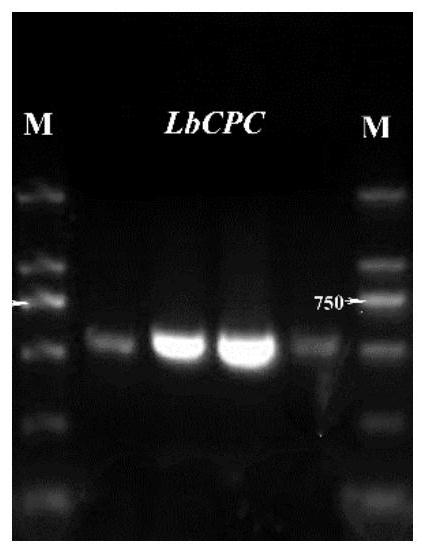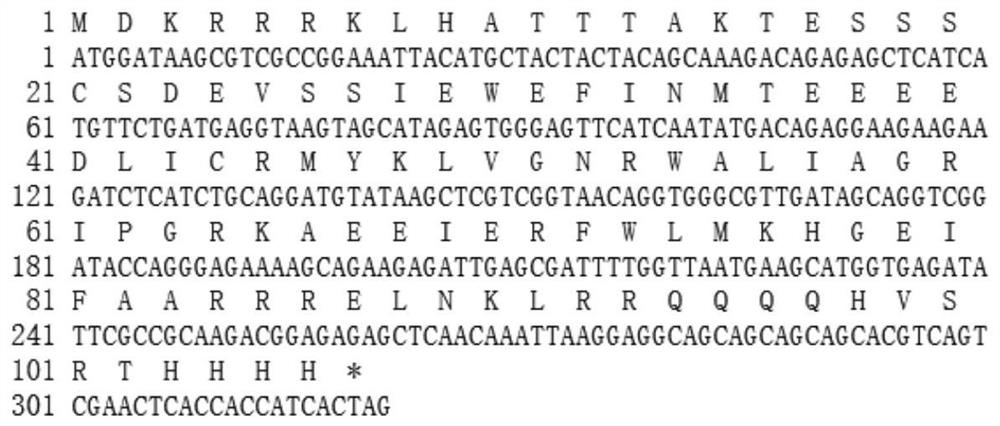Limonium bicolor gene LbCPC and application thereof
A kind of two-color tonic blood grass, gene technology, applied in application, genetic engineering, plant genetic improvement and other directions, can solve desertification, agricultural yield decline, soil degradation and other problems
- Summary
- Abstract
- Description
- Claims
- Application Information
AI Technical Summary
Problems solved by technology
Method used
Image
Examples
Embodiment 1
[0057] Example 1 Cloning and bioinformatics analysis of LbCPC gene
[0058] 1 material
[0059] The seeds of Limonium bicolor (Bunge) O. Kuntze were collected from the saline-alkali land of the Yellow River Delta in Dongying City, Shandong Province, China. After fully drying, store in the refrigerator at 4°C. The seeds with uniform size and full grain were selected for irradiation mutagenesis treatment.
[0060] 2 Experimental methods
[0061] 2.1 LbCPC cloning and bioinformatics analysis
[0062] Total RNA was extracted from the leaves of Limonium bicolor at the salt gland development stage (stage A), and cDNA was obtained by reverse transcription kit. According to the previous second-generation transcriptome data, combined with 3'RACE and 5'RACE technology, primers were designed to clone the LbCPC gene of Limonium bicolor, and bioinformatics analysis was performed.
[0063] 2.1.1 Disinfection and cultivation of Limonium bicolor seeds
[0064] Put Limonium bicolor seeds...
Embodiment 2
[0131] Cloning and functional analysis of embodiment 2 gene LbCPC promoter
[0132] 1 Cloning of LbCPC Gene Promoter of Limonium bicolor
[0133] According to the DNA sequence of the gene, primers were designed to clone the DNA flanking sequence at the 5' end of the gene (Table 3).
[0134] Table 3 Primers used for cloning the 5' end DNA flanking sequence of LbCPC gene
[0135]
[0136] Use the TaKaRa Genome Walking Kit (Code No.6108) for the reaction, using the leaf genomic DNA as a template, and the reaction steps are as follows:
[0137] (1) 1st PCR reaction:
[0138] The first PCR reaction was performed with AP1 (AP2, AP3, and AP4 performed simultaneously) as the upstream primer and 5SP1 as the downstream primer.
[0139] ① Prepare 1st PCR reaction solution according to the following components.
[0140]
[0141] ②1st PCR reaction conditions are as follows:
[0142]
[0143] (2) 2nd PCR reaction:
[0144] After diluting the 1st PCR reaction solution by 1 to ...
Embodiment 3
[0173] Example 3 Construction of LbCPC Overexpression Vector and Transgenic Plants
[0174] 1LbCPC over-expression carrier construction
[0175] (1) Use Takra high-fidelity enzyme to clone the CDS sequence of the gene, add KpnⅠ and BamHI restriction sites and corresponding protective bases at both ends of the primers (Table 5), connect to the pEASY T3 cloning vector after gel cutting, and transform into Escherichia coli Afterwards, the plasmid was extracted and digested with pCAMBIA 1300-35S-sGFP expression vector. The reaction system was as follows: KpnⅠ(BamHI) 1 μl, vector or plasmid 1 μg, CutSmart Buffer 5 μl, H 2 O make up to 50 μl. React at 37°C for 30 minutes.
[0176] (2) After the digestion is completed, perform agarose gel electrophoresis on the digested product, and then cut out the target fragment in the agarose gel, then use the gel recovery kit to recover the DNA fragment, and use T4 ligase to connect the digested carrier and fragments, the ligation reaction sy...
PUM
| Property | Measurement | Unit |
|---|---|---|
| diameter | aaaaa | aaaaa |
Abstract
Description
Claims
Application Information
 Login to View More
Login to View More - R&D
- Intellectual Property
- Life Sciences
- Materials
- Tech Scout
- Unparalleled Data Quality
- Higher Quality Content
- 60% Fewer Hallucinations
Browse by: Latest US Patents, China's latest patents, Technical Efficacy Thesaurus, Application Domain, Technology Topic, Popular Technical Reports.
© 2025 PatSnap. All rights reserved.Legal|Privacy policy|Modern Slavery Act Transparency Statement|Sitemap|About US| Contact US: help@patsnap.com



